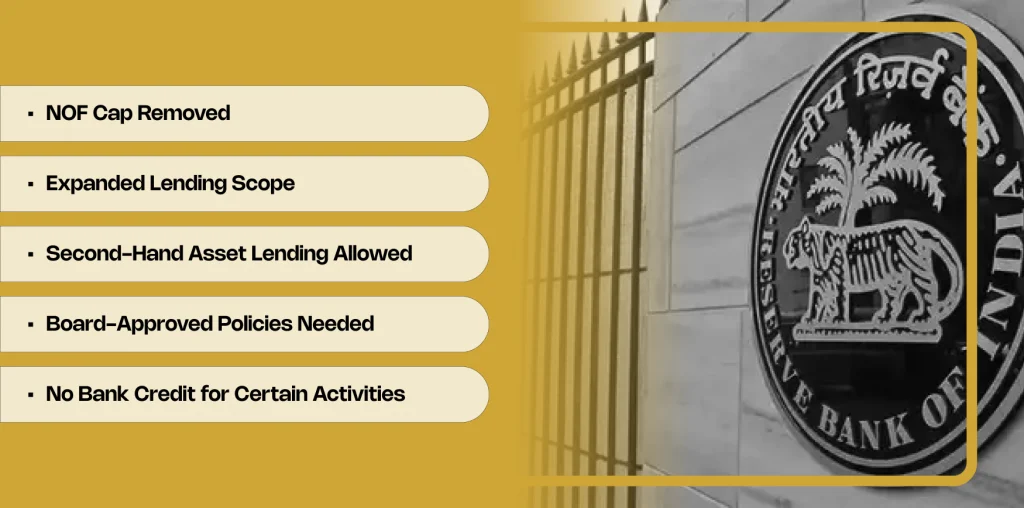The Reserve Bank of India (RBI) has released a consolidated Master Circular on Bank Finance to NBFCs, effective April 1, 2025. The circular removes the earlier cap on bank lending linked to Net Owned Funds (NOF) for registered NBFCs, and lays down clear guidelines on permissible and restricted lending activities. Fintechs operating as NBFCs or in partnership with them should closely assess the implications, especially around excluded activities, exposure ceilings, and factoring rules.
Context
NBFCs are the backbone of India’s credit ecosystem, especially in areas underserved by traditional banks. They bridge the gap in consumer and SME lending, leasing, and innovative credit delivery models. RBI’s periodic oversight ensures this sector remains resilient without posing systemic risks. Until now, bank lending to NBFCs was capped in relation to their Net Owned Funds (NOF). However, as the sector matures and better risk management frameworks are in place, RBI is shifting towards greater operational flexibility while still enforcing prudential safeguards.
The Master Circular issued in April 2025 consolidates all prior guidelines on this topic up to March 31, 2025, without introducing new regulations. It brings clarity to what banks can and cannot finance when dealing with NBFCs, and offers much-needed structure for fintechs engaging in asset-backed lending, factoring, gold finance, and co-lending models.
Key Highlights

1. NOF Cap Removed: Banks can now lend to all RBI-registered NBFCs (including HFCs) without any linkage to their Net Owned Funds.
2. Expanded Lending Scope: Banks may offer term loans and working capital facilities to NBFCs engaged in infrastructure, hire purchase, equipment leasing, loans, factoring, and investments.
3. Second-Hand Asset Lending Allowed: NBFCs involved in financing used equipment or vehicles can now access bank funds secured against those assets.
4. Board-Approved Policies Needed: Banks must formulate internal policies, approved by their Board, to manage their NBFC exposure within regulatory norms.
5. No Bank Credit for Certain Activities: The circular bans lending to NBFCs for:
• Discounting bills (except auto and two/three-wheelers from manufacturers to dealers)
• Investments in shares or debentures
• Unsecured inter-corporate loans
• Lending to subsidiaries or group companies
• IPO financing or secondary market share purchases
• Factoring NBFCs Must Qualify:
• Must derive ≥50% income from factoring
• Receivables must form ≥50% of total assets
• Must comply with the Factoring Regulation Act, 2011
• Strict Prohibitions:
• No bridge or interim finance
• No lending against the collateral of shares
• No guarantees for placement of funds with NBFCs
• Exposure Ceilings:
• 20% cap on exposure to a single NBFC (ex-gold NBFCs)
• 25% cap on exposure to a group of NBFCs
• 7.5% cap for gold NBFCs, extendable to 12.5% for infra on-lending
• Banks must define internal limits for aggregate NBFC exposure
• Investment Restrictions: Banks must follow RBI’s rules on investing in securities or instruments issued by NBFCs (per RBI’s Investment Portfolio Directions).
• Risk Weights: Lending to NBFCs attracts capital charges based on the RBI’s Basel III Capital Regulations.
Impact on Fintechs

For Founders and Product Teams:
- Clear Lending Pathways: The removal of NOF caps means faster scaling for NBFCs in asset-backed lending, SME finance, and used vehicle financing. Banks can now lend based on risk profiling rather than ownership structure.
- Product Structuring: Ensure lending products are not structured around restricted activities (like IPO funding or unsecured ICDs). Add logic in backend systems to flag such disallowed end-use cases.
- Factoring Platforms: If your startup offers invoice discounting, make sure you qualify as an NBFC-Factor and meet the income/asset thresholds to access bank finance.
- Gold Loan NBFCs: Check your capital adequacy and infra-lending splits to stay within exposure caps and avoid rejection from banking partners.
For Compliance Officers:
- Review partner NBFC portfolios to ensure alignment with RBI’s exclusion list.
- Monitor exposure caps, especially if you deal with multiple NBFC partners.
- Update internal risk frameworks and credit appraisal processes accordingly.
For Engineers & Ops Teams:
- Automate restrictions on end-use of funds.
- Integrate compliance checks into lending workflows.
- Implement sub-limits for gold loan NBFCs and group exposures.
Deadline & Enforcement
- The circular is effective from April 1, 2025.
- It consolidates all rules till March 31, 2025.
- It does not introduce new rules, but enforces existing ones in a streamlined format.
Conclusion
RBI’s Master Circular marks a decisive shift toward trust-based regulation. By relaxing the NOF cap, RBI is enabling responsible growth for NBFCs. However, fintechs must be vigilant: the exclusions are strict, the ceilings clear, and the compliance burden has shifted onto internal bank frameworks.
This is the right time to review your NBFC arrangements, product use-cases, and exposure management tools. Make sure your legal, engineering, and compliance teams are aligned.
Need help mapping your lending stack to RBI compliance? BeFiSc’s compliance intelligence tools can monitor real-time exposure limits, flag restricted activities, and streamline documentation. Learn more at www.befisc.com




